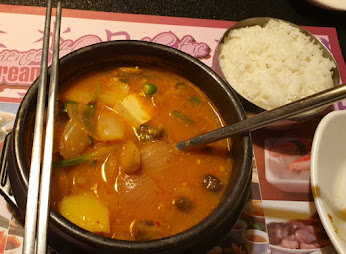Savoring Traditions: Exploring ‘Jjigae’, ‘Rasam’ and other Culinary Delights of Korea and India
Jjigae, a popular Korean dish, and Rasam, a beloved South Indian staple, are both renowned for their rich flavors. While they differ in ingredients and preparation methods, they share a common goal of satisfying taste buds and bringing comfort to the dining table.
Comparing Jjigae and Rasam:
Flavor Profiles: Jjigae is a Korean stew known for its hearty, savory taste, often featuring ingredients like tofu, vegetables, and meat or seafood. On the other hand, Rasam is a tangy South Indian soup made with tamarind, tomatoes, and a blend of aromatic spices, offering a unique balance of spiciness and tanginess.
Ingredient Variations: While both Jjigae and Rasam incorporate spices and herbs, their ingredient choices differ. Jjigae often includes Korean seasonings like gochujang (red chili paste) and soybean paste, while Rasam utilizes South Indian spices like mustard seeds, curry leaves, and asafoetida.
Main Course vs. Soup: Jjigae is typically enjoyed as a main course, served alongside steamed rice and an array of side dishes known as banchan. In contrast, Rasam is often served as a soup course or mixed with rice, providing a refreshing and appetizing start to a South Indian meal.
Regional Significance: Jjigae holds a significant place in Korean cuisine, with various regional variations highlighting local ingredients and culinary traditions. Similarly, Rasam is an integral part of South Indian cuisine, with each region adding its unique touch by incorporating local spices and flavors.
Cultural Significance: Both Jjigae and Rasam are considered comfort foods that evoke a sense of nostalgia and warmth. They are often prepared during festive occasions, family gatherings, and times when a wholesome and flavorful meal is desired.
Other Comparable Dishes in South Korean and South Indian Cuisine:
Kimchi and Pickles: Both South Korea and South India boast a variety of fermented and pickled dishes that add depth and tanginess to meals. Kimchi, a staple in Korean cuisine, shares similarities with South Indian pickles made from ingredients like mango, lemon, or mixed vegetables.
Pancakes: South Korea's popular seafood or vegetable pancakes, known as jeon, find a counterpart in South India's delectable variety of dosas and uthapams. These savory pancakes offer a delightful combination of flavors and textures.
Rice-based Dishes: Rice plays a fundamental role in both South Korean and South Indian cuisine. Dishes like bibimbap in Korea and biriyani in South India highlight the versatility of rice and are cherished for their harmonious blend of flavors.
Snacks and Street Food: Street food culture thrives in both South Korea and South India. While South Korea boasts favorites like tteokbokki (spicy rice cakes) and kimbap (seaweed rice rolls), South India offers mouthwatering treats like vada, bajji, bonda and various types of savory snacks.
Common Dining Etiquette in Korea & India:
Sharing Culture: Both Korea and India have a strong culture of sharing meals and dishes. It is common for people to share food from communal plates and for hosts to ensure guests are well-fed and satisfied.
Respectful Dining: In both countries, it is customary to show respect and gratitude to the host by accepting food with both hands and avoiding wastage. Additionally, removing shoes before entering a home or dining area is a sign of respect in both Korean and Indian cultures.
Politeness and Table Manners: Koreans and Indians value polite and respectful behavior at the dining table. This includes avoiding loud chewing, slurping, or talking with food in the mouth. Expressing appreciation for the meal and complimenting the host's cooking is also common.
Rituals and Customs: In Korea, the traditional practice of "gukmul" involves serving clear soup at the beginning of a meal to cleanse the palate. Similarly, in India, it is customary to start a meal with a small portion of yogurt or a mild dish to aid digestion. These rituals demonstrate the importance of balance and harmony in both cuisines.
Tea and Beverage Etiquette: Tea holds a special place in both Korean and Indian cultures. In South Korea, the tea ceremony known as "darye" emphasizes grace, mindfulness, and the appreciation of tea. In India, serving tea or coffee as a gesture of hospitality is common, and guests are often offered multiple refills to signify warmth and welcome.
Despite the geographical distance between Korea and India, there are striking similarities in dining etiquette that highlight the shared values of respect, hospitality, and the joy of communal dining. These cultural practices add an extra layer of richness to the gastronomic experiences in both regions.





Comments
Post a Comment